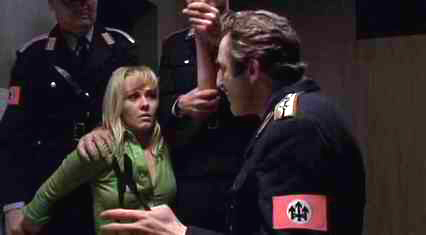
I’m a big Charles Bronson fan, and he was a major star of the Grindhouse Era, once he started down the path of the Death Wish franchise. Before Death Wish turned him into a U.S. star, he was famously a big thing in Europe. Later on in this project, we will get to his output in those days, but up until that huge hit, he was a reliable presence in mainstream Hollywood film, like “The Magnificent Seven”, “The Great Escape” and “The Dirty Dozen”. At the close of the seventies, he was making films for Dino DeLaurentis and his box office was on the decline. He re-paired with Director Michael Winner to make this sequel to Death Wish, and his stature was never the same, because this is a simple brutal exploitation film, and with few exceptions after, those would be the kinds of films he would make.
Paul Kersey is still an architect, only now he lives in Los Angeles, dates a beautiful newswoman, and has moved his formerly catatonic daughter to a recovery center near him and she is making progress. So it all looks good, except at the start of the film, we hear crime statistics being presented on the radio, and inevitably, our New York vigilante will be back in action. The original film contained an assault on Kersey’s family that was horrifying and more explicit than we had seen in mainstream movies up to that point. Director Michael Winner upped the ante here with two rape scenes, the first of which brought howls of protest from critics about it’s gratuity. The housekeeper/maid is brutalized on screen in multiple shots that come close to being pornographic.

The first time I saw this film was in it’s original release, and I went with my wife and another couple. Both of the women we saw this with were traumatized by the film and unhappy that we had selected it for our date night. Completely understandable, and a mistake on my part for sure. In spite of the obvious exploitation, the rest of the film does try to bring a story to the screen that is not bad.
Kersey’s actions in this film differ from those in the first. In this case he is specifically targeting the gang that committed the crimes against his family. The generic social context of the crime issue is replaced with a straight revenge story, and that is much more in the wheelhouse of these exploitation films.

The imagery is definitely designed to make these particular criminals the subject of the audience’s ire, and thus make us root for the vigilante as he tracks them down. There is a good idea in the film, to bring in the cop played by Vincent Gardenia from NY, to consult with the LAPD, but it is the meeting in NYC with the police commissioners that makes the whole thing intriguing. They are worried that if Kersey gets caught, he will spill the beans about how they let him go without being prosecuted in NY. So there is a chance for a political element to sneak into the film. Ultimately that does not pay off, and Gardenia, after some cat and mouse following of Kersey, leaves the picture, and we are back to the revenge plot.
The cast of killers in the gang includes future star Laurence Fishburne.

He gets his in the most elaborate shootout scene in the movie. His character has been carrying a boombox for most of the film, so you know…Chekov’s boombox!


Well before Arnold was making quips with the vermin he was going to take out, Paul Kersey has a come to Jesus moment with the first of the bad guys he catches up with.

The last part of the film is an elaborate plan to execute the final gang member in the mental facility that he has been placed in. The deaths of the criminals have to be dramatic to satisfy the audience’s blood lust. A year after this movie, Clint Eastwood not only dispatches one of the bad guys as Dirty Harry with a big gun, but also has him plunge down on top of a carousel and get impaled by a wooden unicorn. Charles Bronson only manages a bit of electrocution.
The end of the film, clearly leaves the path open for Paul Kersey to return, and it contains a nice shot that will make us want that to happen.






